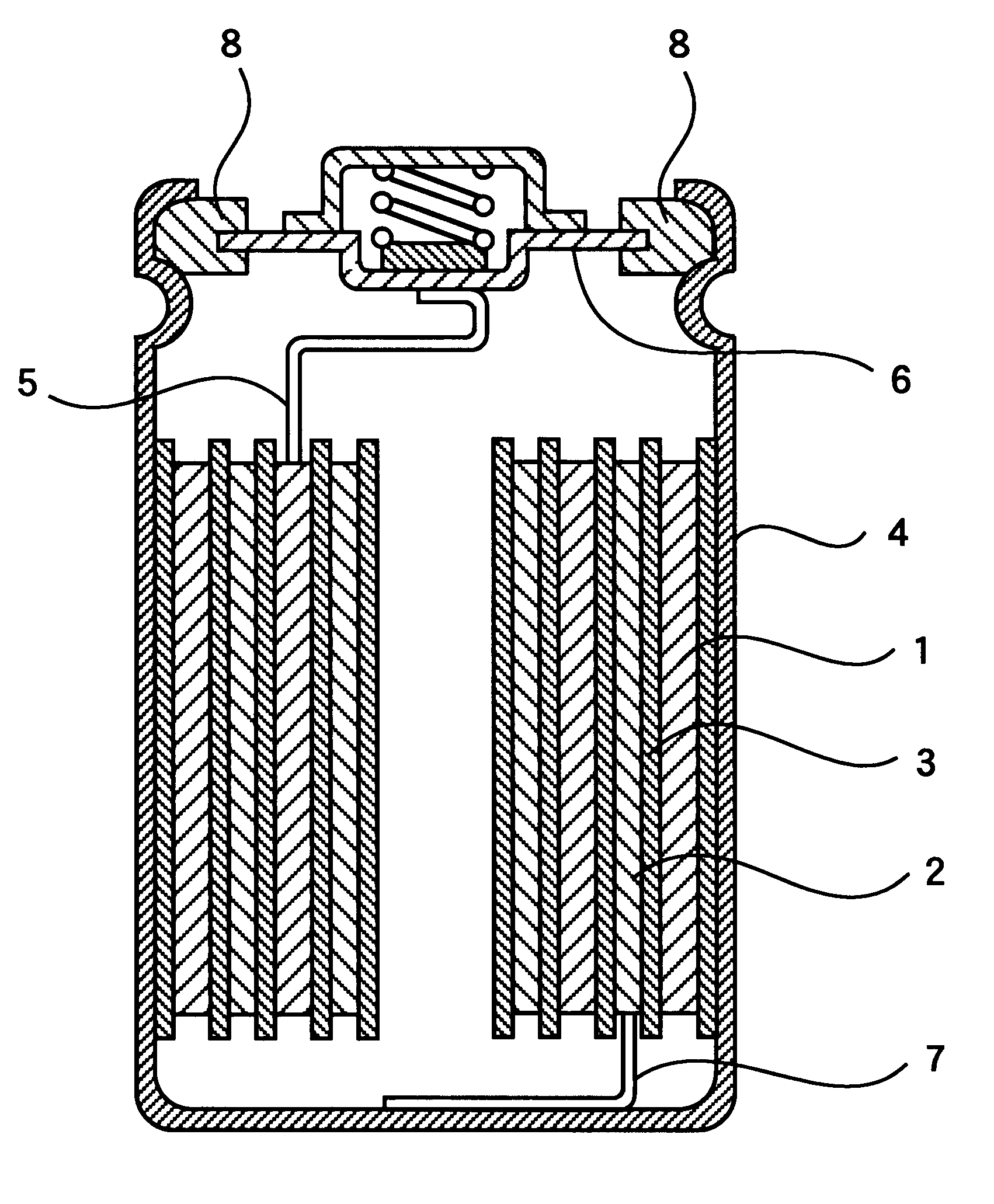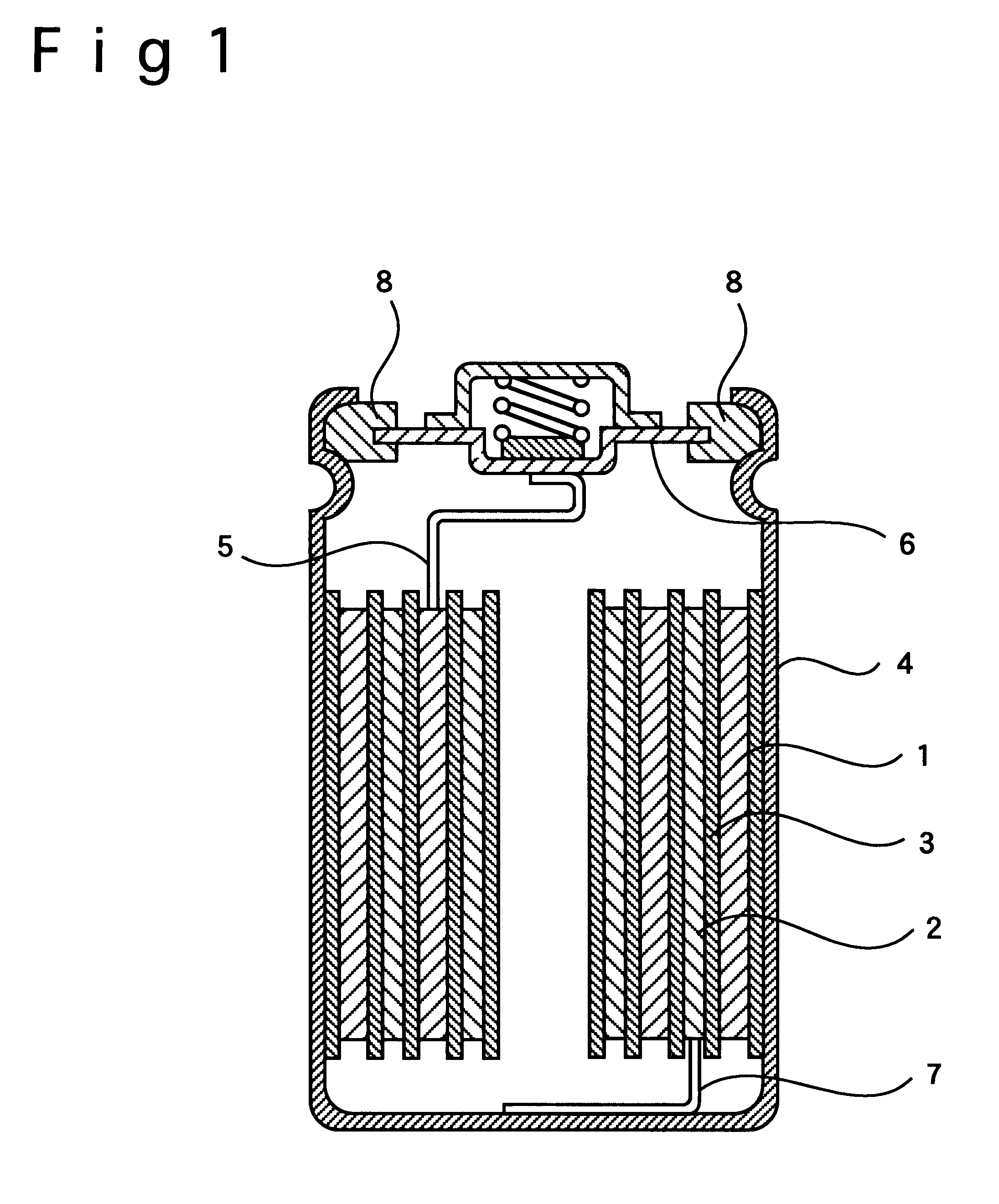Non-aqueous electrolytic secondary cell
a secondary cell, non-aqueous electrolyte technology, applied in the direction of non-aqueous electrolyte cells, cell components, electrochemical generators, etc., can solve the problems of high cost of lithiated cobalt oxide, degraded cycle performance, degraded charging/discharging efficiency, etc., to prevent overdischarge and high viscosity of non-aqueous electrolyte solution
- Summary
- Abstract
- Description
- Claims
- Application Information
AI Technical Summary
Benefits of technology
Problems solved by technology
Method used
Image
Examples
examples a1
to A4 and Comparative Examples Q1 to Q3
In each of the examples A1 to A4 and the comparative examples Q1 to Q3, a positive electrode and a negative electrode were produced in the following manner, and a non-aqueous electrolytic solution is prepared in the following manner, to fabricate a cylindrical-type non-aqueous electrolyte secondary battery of AA-size as shown in FIG. 1.
In producing a positive electrode, LiNi.sub.0.8 Co.sub.0.2 O.sub.2 was used as a positive electrode material. The positive electrode material LiNi.sub.0.8 Co.sub.0.2 O.sub.2, artificial carbon as a conductive agent, and polyvinylidene fluoride as a binding agent were mixed in the weight ratio of 90:5:5. N-methyl-2-pyrolidone (NMP) was added to a mixture obtained, and the mixture was brought into a slurry. Next, the slurry was applied to the both sides of an aluminum foil as a positive-electrode current collector by means of the doctor blade coating method. The slurry on the positive-electrode current collector wa...
examples c1 to c8
In the examples C1 to C8, non-aqueous electrolyte secondary batteries were fabricated in the same manner as that in the above-mentioned examples A1 to A4 and comparative examples Q1 to Q3, except that only the cyclic carbonic esters and the chain carbonic esters used in the preparation of the non-aqueous electrolyte solutions in the examples A1 to A4 and comparative examples Q1 to Q3 were changed as shown in the following Table 3.
As shown in Table 3, in each of the non-aqueous electrolyte secondary batteries in the examples c1 to c8, the total content of the cyclic carbonic ester and the chain carbonic ester was not less than 80% by volume of the whole solvent, and the cyclic carbonic ester in the solvent was changed to propylene carbonate (PC) in the example C1, the cyclic carbonic ester was changed to EC and PC in the example C2, the chain carbonic ester was changed to methyl ethyl carbonate (MEC) in the example C3, the chain carbonic ester was changed to methyl propyl carbonate (...
examples e1 and e2
In each of the examples E1 and E2, LiNi.sub.0.4 Mn.sub.0.3 Co.sub.0.3 O.sub.2 was used as the positive electrode material as in the non-aqueous electrolyte secondary batteries of the above-mentioned examples D1 to D5, while propylene carbonate (PC) and butylene carbonate (BC) were respectively used as the cyclic carbonic esters in the solvents of the non-aqueous electrolyte solutions in the examples E1 and E2 in place of ethylene carbonate (EC), as shown in the following Table 5. Each of these cyclic carbonic esters was respectively mixed with 1,2-dimethoxyethane (DME) in the volume ratio of 50:50 as in the above-mentioned examples D3. Except for the above, the same procedure as in each of the above-mentioned examples D1 to D5 was taken to fabricate non-aqueous electrolyte secondary batteries according to examples E1 and E2.
In each of the non-aqueous electrolyte secondary batteries according to the examples E1 and E2 thus fabricated, 100 cycles of charging and discharging were perfo...
PUM
| Property | Measurement | Unit |
|---|---|---|
| charge cut-off voltage | aaaaa | aaaaa |
| battery voltage | aaaaa | aaaaa |
| voltage | aaaaa | aaaaa |
Abstract
Description
Claims
Application Information
 Login to View More
Login to View More - R&D
- Intellectual Property
- Life Sciences
- Materials
- Tech Scout
- Unparalleled Data Quality
- Higher Quality Content
- 60% Fewer Hallucinations
Browse by: Latest US Patents, China's latest patents, Technical Efficacy Thesaurus, Application Domain, Technology Topic, Popular Technical Reports.
© 2025 PatSnap. All rights reserved.Legal|Privacy policy|Modern Slavery Act Transparency Statement|Sitemap|About US| Contact US: help@patsnap.com


